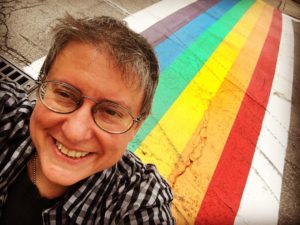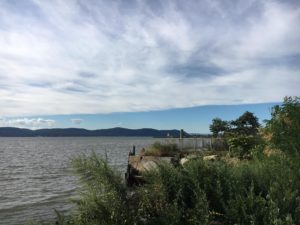
[image description: a transmasculine person smiles in front of the rainbow crosswalk painted for Pride Week in Houston’s Montrose neighborhood. Image © 2017, Max Sparrow]
Like most (all?) humans, I am greatly enriched by any and all support during this intense time of great change. And I am blessed to have so much support and so much love from others.
I want to talk about layers and intensities of friendship and love from my Autistic perspective. This is just me — other Autists might be different, so don’t assume that I’m telling you some kind of universal Autistic thing. Take my experience as a first step in asking questions and working to understand yourself or the Autists in your life.
The phrase “inner circle” has a lot of meaning to me because I have a small but very important inner circle. My inner circle consists of one or two people with whom I am engaging in a deeply intimate and trusting manner. I seem mainly to only be able to hold one person in my inner circle at a time, although for the last couple of months I was holding two people in there. It was very difficult and I found myself feeling like I was oscillating between the two people in my inner circle.
I credit (whether accurately or not) my Autistic neurology for my very small inner circle. I have tried to expand my inner circle and I just can’t. This is the place where a best friend and/or a lover fits into my life. While I admire polyamory, I have not been able to engage in polyamory myself because trying to fit more than one person into my inner circle causes struggle. Trying to fit more than two people into my inner circle causes tragic implosion. It might be possible, but it turns out to be highly ill-advised for me. Growing up, I wasn’t even able to hold both my mother and my father in my inner circle at the same time.
Because my most inner circle of friendship is this tiny demitasse cup, most of my life my best friend, mentor, and closest confidant has also been my lover. This is dangerous. The saying is “don’t put all your eggs in one basket.” Problems arise when everything is poured into one person. There is so much opportunity for abuse (in either direction). It is more likely that too many of my needs will get heaped on the one person who will get burned out as a result. If that one person withdraws their presence from my inner circle, the vacuum they leave behind can be devastating.
There is another difficulty that comes from having a demitasse inner circle. I have noticed a pattern. There is a type of person who understands how to climb right into my demitasse — even, sometimes, to the point of displacing someone else who actually belongs in there — almost immediately. Once in there, they enjoy all kinds of fun and games at my expense (and usually to my great confusion and consternation as well) and then either they lose interest and drop me cold (leaving me to suffer that vacuum of the sudden absence of a person who I had allowed in to the most inner chamber of my being) or I begin to awaken to the toxic nature of what I have been allowing to happen and I evict them myself.
(I’ve also had people inexpertly try to break down the door to my inner circle but get held at arm’s length due to their clumsy attempts to manipulate me being so obvious. This sort gets angry and bludgeons me in some way for refusing to allow them entry. The last person who did this to me ended up sending the police to my door because I didn’t answer their text for 45 minutes.)
I try to be an open person. There is risk there. People slip into greater intimacy than I should be allowing them. Some of them use or hurt me. I am learning how to guard against that. There is also a great risk in being a closed person. In closing myself off and not letting anyone in, I may be impoverishing myself and not discovering who I am. But yes, human contact is important to me. One big reason I adopted a nomadic lifestyle was so that I could expand my world by meeting more people.
Anyway, I have other levels of friendship. The next level is pretty big and I have a lot of people in there. Some of them I don’t talk to for weeks or months at a time but when we connect again we pick up the conversation as if only a moment had passed since the last things we said to one another. These are people I love deeply and am deeply grateful for. Then there is a huge swath of acquaintanceship with a great many people with whom I have limited interactions. They are people I admire and respect but we have a connection that I consider to be more “surface” (although, compared to how I see friendship discussed by others, I suspect my “surface” is still pretty “deep” for most people. I credit Autistic neurology for this, too. We don’t tend to do chit-chat.)
But that innermost level…I have not made the best choices about who I allow in there. I have accidentally ended up with someone marvelous in there, and been very grateful. And I have accidentally ended up with someone destructive in there. Sadly, the latter has happened more often than the former.
I have been doing a lot of thinking lately about my inner circle and how vulnerable this model of relating can make me. Times, when I’ve had no one in my inner circle, has been bleak and desolate. But I’ve been wondering whether that is necessary. It certainly isn’t desirable.
And what I’ve been thinking about most is this:
Can I be in my own inner circle?
And I think that question is key to a personal breakthrough.


Recent Comments